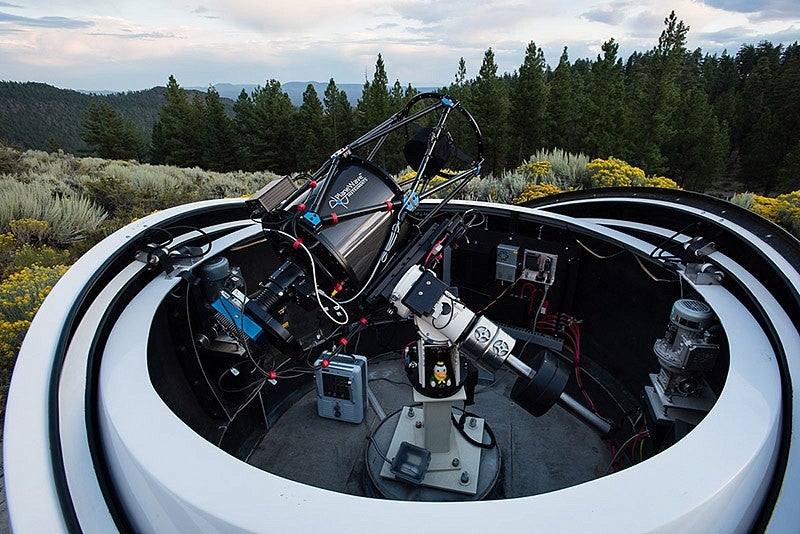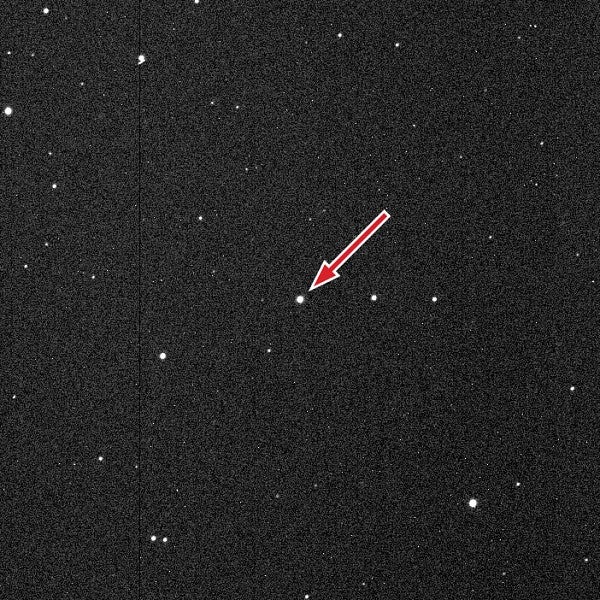As dusk creeps over the high desert of central Oregon on a cool September evening, a small but fiercely enthusiastic group of University of Oregon students can hardly contain their glee. Obsessed by stars, gaga over galaxies, drawn to the infinite mysteries of the universe, they are planning to stay up all night at the UO Pine Mountain Observatory.
“It’s such a cool juxtaposition between the calm of the day and the hustle and bustle of nighttime, because everyone is so excited about seeing this giant dome of stars,” says Maggie Thompson, a member of the class of 2021.
RELATED LINKS
Thompson, Odelia Hartl, and Nicole Ringsdorf are members of an undergraduate research group named Fishergroup, under astronomy lecturer Scott Fisher. Thompson and Ringsdorf both decided to become physics majors after they took Fisher’s wildly popular 100-level astronomy class. They also signed up for summer volunteer work at the UO Pine Mountain Observatory, which sits on a remote mountaintop about 30 miles southeast of Bend.
On weekends when moonlight doesn’t overpower the light from distant stars, the students share their astronomical knowledge with the public, offering views through a variety of instruments—including a fully restored, antique 15-inch telescope—and explaining the night sky. “Pine Mountain is a wonderful place for the public to get excited about science,” Thompson says.
Interacting with the public is as important as learning to do research, Fisher says. “I am a huge proponent of science communication,” he adds. “We want our physics majors and hardcore scientists to be able to explain science and speak about what they’re doing. Speaking to the public is both terrifying and fulfilling at the same time. It’s an excellent exercise for the students, especially so early in their career.”
Typically, after satisfying the visitors’ curiosity, the students spend the rest of the night making astronomical observations. This includes taking images through a remote-controlled research telescope that they helped build—nicknamed “the Robbins” after donor Kenneth Robbins—and writing software code that processes the images.
“There have been plenty of times when we have stayed up until the sun starts to come up at four or five in the morning,” says Jonah Rose, BS ’19 (physics, mathematics and computer science), now in his first year of a PhD program in astrophysics at the University of Florida.

Last September, during one of those late-night observing runs, Rose, Thompson, and Hartl took roughly 250 images of an asteroid named Minerva over a three-hour period. Asteroids, rocky objects that orbit the sun in the so-named Asteroid Belt between Mars and Jupiter, are not very big, and they are very distant from Earth. (Minerva, for example, is only 60 miles across and is roughly 250 million miles away.)
Because of their size and distance, it’s not possible to directly ascertain asteroids’ shapes from images. However, as they move along their orbit they also tumble and rotate, reflecting different amounts of light as they turn various sides toward the sun. This allows astronomers to create a “light curve” by measuring how the brightness of an asteroid changes as it moves along its orbit.
In the case of Minerva, the team knew that it rotates once every six hours, so they knew that approximately three hours of data would give them the information needed. The trio wrote code that calibrated the data by removing irrelevant light from the images; then they created a light curve by measuring the brightness of the target in each image. The final light-curve data was compiled and sent to colleagues in Kobe, Japan, for further analysis, including the creation of a 3D model of Minerva.

“This was our first completely student-run project,” Fisher says with evident pride. “Minerva was dead-easy to see, whopping bright, and you could actually see it changing its position. You have this moment when you realize, ‘That’s a rock maybe 60 miles across, and we’re mapping it!’”
The students presented their research at the university’s Undergraduate Research Symposium in May. “Being at Pine Mountain brought to life what scientists actually have to do to gather data,” Hartl says. “It gave me a new perspective on the astronomy world.”

A few months later, Ringsdorf joined the Minerva project. Under the tutelage of Fisher and physics professor Jim Imamura, she learned basic astronomy and then mastered a complicated computer program that measures the brightness of astronomical images. With that under her belt, she analyzed all of the Minerva photos, using other stars with known magnitude or brightness for comparison.
“The learning curve of the software was the hardest part,” says Ringsdorf, who graduated earlier this year. “I spent about 160 hours total on the project. It was all up to me to figure out any problems that I came across. I feel this really set me up for the future.”

The Minerva project gave the students the experience and confidence to take part in the Gemini/Hubble Space Telescope Galaxy Cluster Project, which involves working with international astronomers on data from the telescope and from large observatories in Hawaii and Chile.
“Odelia [Hartl] is our computer programming guru in this generation of Fishergroup,” Fisher says. “She is very precisely simulating the data we have obtained from these large telescopes, so that we can compare the two sets of data by changing the parameters of the simulation. It’s an important way to deeply understand the data we get from the telescopes.”
Hartl, a member of the class of 2020, spent the summer at Texas A&M, taking part in a National Science Foundation–funded research program in which she worked on calculating the mass of the Milky Way galaxy; our neighboring galaxy, Andromeda; and the satellite galaxies orbiting the earth.
“Doing the work at Pine Mountain and being part of the Gemini project made me successful at the Texas research program,” she says. “My life goal is to learn to understand the universe in a different way. And the more I learn, the more obsessed I become. I plan to go into a PhD program, and I want to do research.”
Thompson, on the other hand, has discovered that she prefers public outreach. At Pine Mountain Observatory, she is in her element.
“I feel like a lot of people don’t realize how special PMO is,” she says. “It is a hub of opportunity. I really love it up there—being able to interact with telescopes and also leading the public nights. Science is such a beautiful thing, and I would like to be a bridge between science and the rest of the world.”
Rosemary Camozzi, BA ’96 (journalism: magazine), is a magazine editor and writer in Eugene.


